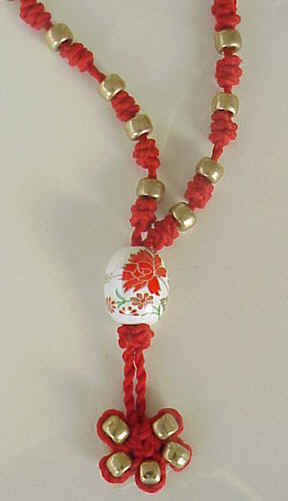If the yarn needs to be bulked up more that three times make samples and plan the ply of the final knotting yarn. For a four ply either: 1) add twist to the singles as for the two and three plies and ply in a strait four ply cord; or 2) add twist to two singles together and then fold but be sure to check the twist of the original yarn and add your first twist in that same direction. Many yarns will need to be bulked up considerably. the most effective way of bulking them up quickly and evenly is to Navajo ply either one or more strands of the original weaving yarn, giving a twist angle of about 45 degrees. Then either Navajo ply them again in the opposite direction on do a convention fold to balance the twist. Sometimes your might want to over spin the second ply and then ply a third time to achieve the desired diameter yarn.
COM1B

SAMPLE COM1B (Sample Card Text)
Sliding Button Knots adjust this necklace to go over your head. Make the necklace long or short. Could not be used with cord that will abrade. Necklaces made with delicate yarns or cords should have metal findings or no closure. Tassels were used historically.
1) Add as much twist as possible on all but the last plies to achieve as hard a cord as possible.
2) Always check the direction of the twist of the initial yarn and twist first in that direction.
3) Try to plan as round a diameter yarn as possible for better defined knots.
4) The yarn needs to be balanced when finished.
5) A fuzzy or textured yarn will not show the knots off well but in some cases is
suitable for a particular project (sample COM7).
6) Variegated colored yarn do not show off most knots well and are difficult to keep
track of the threads while tying the knots.
7) Necessary strength is dependent on the intended use. A cord may be weak if no
tension will be on the final knots.
8) Generally, elasticity is not desirable.